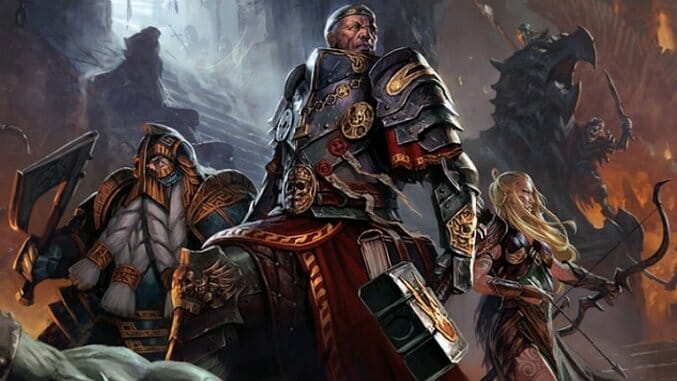
Warhammer Quest: The Adventure Card Game is a role-playing themed … uh, card game, if you didn’t figure that out, but one that manages to capture some of the better qualities of both formats, playing like a boardgame while players still hack and slash their way through a dungeon laid out by the cards. With one campaign included in the base game, it’s perfectly suited to future expansions, but would benefit from more quests that incorporate challenges beyond monster battles.
(Full disclosure: I’ve never played any Warhammer titles, as I don’t do miniatures and lack the time for true role-playing games, so most of the game’s theme was new to me.)
Translating the full role-playing experience to a simple board or card game is difficult, as one of the great pleasures of role-playing games is developing your characters, adding skills to them over repeated plays as they gain strength and power. Adaptations like Warhammer Quest: The Adventure Card Game (hereafter just WQ) have to omit that aspect of game play in favor of static characters, here even limiting the characters to just eight action cards (four basic, four advanced) in the base game, which gives the game a more rote feel than you’d get in a classic RPG where your decision set is much wider. Limiting player options keeps the game manageable in both a physical sense and in a learning-curve sense, potentially opening the game to a broader audience, folks who, like me, don’t have time for long role-playing game sessions or the commitment to play a single game a dozen or more times. And by using location cards to represent rooms or caverns for the dungeon crawls, WQ avoids long setup times and doesn’t require a ton of table space for a central board.
WQ does try to simulate some of the other essential aspects of role-playing adventure games, and does so more successfully than other titles I’ve tried like the recent Temple of Elemental Evil boardgame from Wizards of the Coast. Player engagement in battle is clear and straightforward, with enemy and player dice rolled and resolved together to keep the game flowing. Each player’s turn comprises the same simple steps: activate one action, target one or more enemies, roll dice, resolve player dice and then enemy dice, sometimes drawing cards or taking additional steps as directed by cards already in play. Once every player has taken a turn, the players follow any instructions on the location card (e.g., spawning another enemy card), the “peril” marker increases by one on the main quest board (sometimes triggering additional effects, which are never good), and the next round begins.
Each player’s choices of actions are also simple: attack, aid, explore or rest. Attack cards are as you’d expect, although like all cards in the game they often allow the player to do something else in addition to rolling for damage. Aid cards allow the player to support another player’s actions. Explore cards allow the player to place one or more progress tokens on the location card, which represents the specific room or cavern in which the party is currently fighting; once the tokens on the card meet that card’s progress threshold, the location is explored and the party may move to another location. Resting allows the player to restore some lost hit points. Once a player has activated and used an action card, it is considered “exhausted” and may not be reused until the player plays a card that allows him/her to “ready” all action cards—that is, to un-exhaust them. Each player begins the game with four Basic action cards, but may upgrade each of them to Advanced versions over the course of several plays, beginning with the end of the first stage of the campaign.
The base game comes with just that one campaign, comprising five quests, as well as an additional “delve” quest that’s independent of the main campaign. The game is perfectly set up for future expansions of cards and quests, including (I would hope) some new hero cards and more diverse actions as the number and variety of enemies increases in future decks, although there’s some replay value here because some of the decks you pull for each quest will vary each run-through.
My own personal taste in boardgames veers toward games that are more self-contained, games you finish in a single sitting and that aren’t quite so prescriptive in your move options—for example, giving each character just one method of attack to start the game, before special items or gear become available, makes it seem a bit paint-by-numbers to me. However, distilling the RPG experience into a card game that anyone can learn to play quickly—with help from an easy-to-follow tutorial quest—is a serious challenge, and the designers of Warhammer Quest: The Adventure Card Game have succeeded as well as any I’ve seen.
Keith Law is a senior baseball writer for ESPN.com and an analyst on ESPN’s Baseball Tonight. You can read his baseball content at search.espn.go.com/keith-law and his personal blog the dish, covering games, literature, and more, at meadowparty.com/blog.
